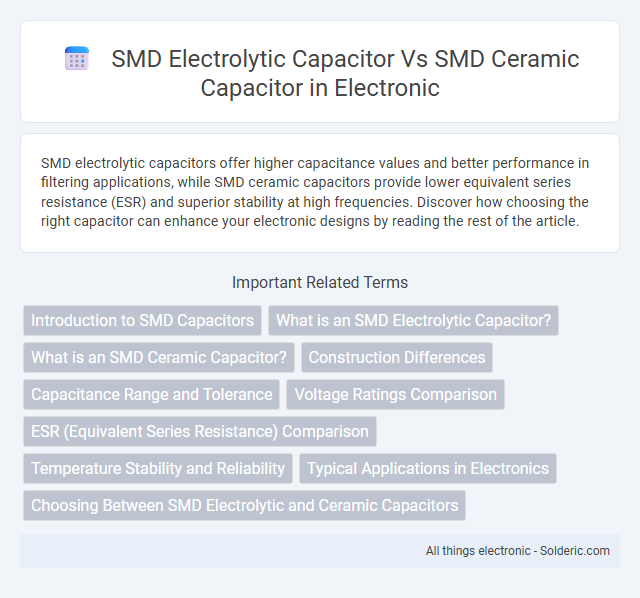SMD electrolytic capacitors offer higher capacitance values and better performance in filtering applications, while SMD ceramic capacitors provide lower equivalent series resistance (ESR) and superior stability at high frequencies. Discover how choosing the right capacitor can enhance your electronic designs by reading the rest of the article.
Comparison Table
| Feature | SMD Electrolytic Capacitor | SMD Ceramic Capacitor |
|---|---|---|
| Capacitance Range | 1 uF to 4700 uF | 0.1 pF to 100 uF |
| Voltage Rating | 6.3V to 100V | 10V to 100V+ |
| Equivalent Series Resistance (ESR) | Higher ESR | Low ESR |
| Leakage Current | Higher leakage current | Very low leakage current |
| Size | Larger for equivalent capacitance | Smaller, compact form |
| Temperature Stability | Moderate, affected by electrolyte | High, depending on dielectric class (e.g., C0G, X7R) |
| Frequency Response | Lower frequency performance | Good high-frequency response |
| Polarization | Polarized | Non-polarized |
| Applications | Bulk filtering, smoothing in power supplies | Decoupling, high-frequency filtering, timing circuits |
| Cost | Generally lower cost per uF | Higher cost per uF |
Introduction to SMD Capacitors
SMD electrolytic capacitors provide high capacitance values and stable performance for power supply filtering and decoupling in compact electronic circuits. SMD ceramic capacitors offer low equivalent series resistance (ESR) and excellent high-frequency characteristics, making them ideal for signal filtering and noise reduction. Both types are surface-mount devices designed for automated PCB assembly, optimizing space and reliability in modern electronic designs.
What is an SMD Electrolytic Capacitor?
An SMD electrolytic capacitor is a surface-mount device designed for high-capacitance applications with polarized construction, typically using aluminum oxide as the dielectric material. It offers large capacitance values in a compact form, making it ideal for power supply filtering and energy storage in electronic circuits. If you're selecting components for your design, understanding the voltage rating and ESR (Equivalent Series Resistance) of SMD electrolytic capacitors is essential to ensure reliable performance.
What is an SMD Ceramic Capacitor?
An SMD ceramic capacitor is a surface-mount device made from ceramic materials that provide high stability and low loss at high frequencies, making it ideal for filtering and decoupling applications in electronic circuits. These capacitors typically offer smaller capacitance values compared to SMD electrolytic capacitors but excel in reliability and tolerance over temperature variations. You can rely on SMD ceramic capacitors for fast response and durability in compact, high-frequency designs.
Construction Differences
SMD electrolytic capacitors are constructed with an aluminum or tantalum anode, a liquid or solid electrolyte, and a cathode, providing high capacitance values in a compact form but with polarity sensitivity. SMD ceramic capacitors use multi-layer ceramic dielectric materials between metal electrodes, offering low equivalent series resistance (ESR) and high-frequency performance without polarity concerns. Your choice depends on the required capacitance, voltage rating, and application frequency due to these fundamental construction differences.
Capacitance Range and Tolerance
SMD electrolytic capacitors typically offer higher capacitance values, ranging from 1uF to several thousand uF, with tolerances commonly around +-20%. In contrast, SMD ceramic capacitors provide lower capacitance values, usually from a few picofarads up to 100uF, but exhibit tighter tolerances, often as low as +-5% or better. Choosing Your capacitor depends on whether high capacitance or precise tolerance is more critical for your application.
Voltage Ratings Comparison
SMD electrolytic capacitors typically offer higher voltage ratings, often ranging from 6.3V to 100V or more, making them suitable for power supply filtering in circuits with elevated voltage levels. In contrast, SMD ceramic capacitors usually have lower voltage ratings, commonly from 16V to 50V, but some specialized types can reach up to 100V. The voltage rating difference impacts the selection process in applications requiring stable performance under specific voltage stress conditions.
ESR (Equivalent Series Resistance) Comparison
SMD ceramic capacitors typically exhibit much lower ESR compared to SMD electrolytic capacitors, making them ideal for high-frequency applications and situations requiring fast transient response. Your choice depends on balancing ESR with capacitance and voltage ratings, as electrolytic capacitors often provide higher capacitance but at the cost of greater ESR. Lower ESR in ceramic capacitors contributes to improved efficiency and reduced heat generation in power supply circuits.
Temperature Stability and Reliability
SMD ceramic capacitors exhibit superior temperature stability with low capacitance variation over a wide temperature range, typically from -55degC to 125degC, making them reliable for precision applications. In contrast, SMD electrolytic capacitors generally have higher ESR and limited temperature endurance, often rated up to 85degC or 105degC, which can impact long-term reliability and performance under thermal stress. The inherent solid dielectric structure of ceramic capacitors enhances their reliability in harsh temperature environments compared to the liquid electrolyte in electrolytic capacitors, which can degrade over time.
Typical Applications in Electronics
SMD electrolytic capacitors are commonly used in power supply filtering, decoupling, and energy storage applications due to their high capacitance and voltage ratings. SMD ceramic capacitors excel in high-frequency signal filtering, noise suppression, and timing circuits because of their low equivalent series resistance (ESR) and stability over a wide temperature range. Your choice between these capacitors depends on the specific requirements of your electronic circuit, such as capacitance needs, size constraints, and frequency response.
Choosing Between SMD Electrolytic and Ceramic Capacitors
SMD electrolytic capacitors offer high capacitance values and are ideal for bulk energy storage and filtering in power supply circuits. SMD ceramic capacitors provide low equivalent series resistance (ESR), high stability, and excellent high-frequency performance, making them suitable for decoupling and signal integrity applications. Selecting the appropriate capacitor depends on factors such as capacitance requirements, voltage ratings, frequency response, and circuit design constraints.
SMD electrolytic capacitor vs SMD ceramic capacitor Infographic

 solderic.com
solderic.com